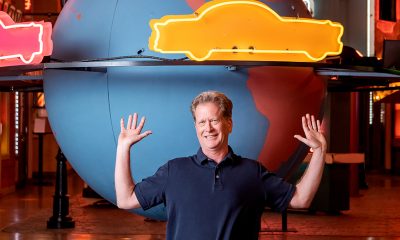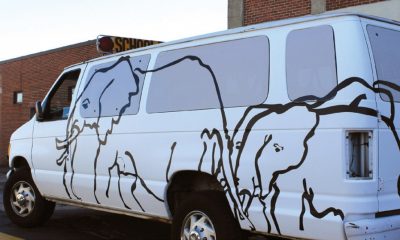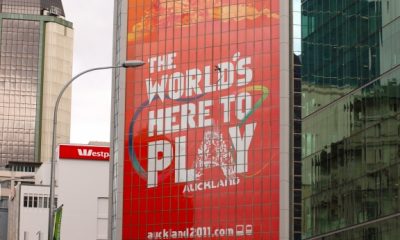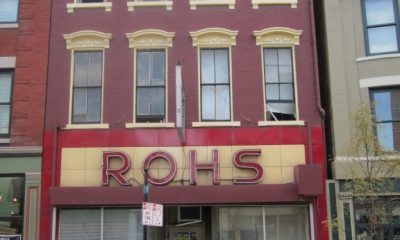News
An Open(wood) Book
This Wisconsin signshop has built a strong niche.
Published
15 years agoon

Opposing schools of thought debate whether depth or breadth is more important. Rick Steves has cultivated an exciting career crisscrossing Europe as host of a PBS travel show, whereas Henry David Thoreau recounted having “traveled extensively in Concord” – that is, getting to know the community and its residents on a deeper, more intimate level.
Signshops face similarly divergent paths. An owner may choose to stock an extensive inventory of tools and equipment to cater to a broad swath of customers, or choose to develop more in-depth relationships in a specialized market. Relevant factors may include the company’s staff (and, if necessary, available subcontractors), its equipment, relationships with developers and the most fruitful potential client base.
Dale Ganser, proprietor of Madison, WI-based Openwood Studios since his college days, has chosen to primarily pursue niche markets – specifically, hospitality and municipal signage and wayfinding. Though proximity to tourist-friendly Wisconsin Dells and Door County helped him develop strong signage and graphic programs, Ganser has also regional and national clientele.
A good fit
Ganser enrolled in the fine-arts program at the University of Wisconsin-Madison; his self-directed curriculum included graphic arts and business management. His longtime interest in woodworking evolved into a collegiate career that coincided with the renaissance of 3-D wood signage in the late ’70s, which facilitated his transition to the sign business.
Advertisement“Sign companies in the area called our department for design assistance, and I became involved with different projects,” Ganser said. “I’d read several articles in [ST] about dimensional signmaking, and I thought it would be an ideal combination of my talents and education. For credit in my last semester at school, I opened my own shop.”
Ganser set up shop in his father’s home-improvement warehouse with a table saw, lettering brushes, a set of hand tools, and his drive and ability.
“It was a very small space,” he recalled. “We didn’t have room for sandblasting equipment, so I subbed this work out to a local monument company. A shop’s early days are usually pretty lean, but word travels when you do good work.”
Building a brand
In 1983, Ganser purchased the 14,000-sq.-ft. building Openwood Studios currently occupies. He’s updated the shop with a Gerber Sabre 408 CNC router, a Mimaki JV-3 solvent-ink printer and stencil-cutting equipment, but he remains true to his handcrafting roots.
Advertisement“I’ve developed good relationships with several contractors who handle electrical and other types of signage,” Ganser said. “I think it’s a much smarter model for a shop to keep the work it does most ably and efficiently inhouse.”
Proximate to such tourist-laden Wisconsin locales as the Dells and Door County, he marketed his trade to local resorts. Although these projects commonly shared tight deadlines and broad environmental-graphic needs, client philosophies diverged.
“All of these properties required hundreds, if not thousands, of signs that vary from a 30-ft.-tall, pylon sign down to room IDs,” Ganser said. “But, some clients want to be closely involved with every creative decision, whereas others just want periodic status reports until the deadline, and to finish at or under budget. Of course, I prefer the latter type.”
Occasionally, Openwood’s clients will present tentative logo designs or renderings prepared by a marketing or advertising agency. But, they typically entrust Openwood Studops to execute the branding, design and development of the environmental-graphics program. He said, “We usually begin our process with a site survey to determine the property’s scope and signage needs, research respective themes and develop rough renderings for client review.”
The interaction between the sheer volume of players – the general contractor, the subcontractor and various tradesmen and vendors who require access during construction and renovation — required for a large hospitality facility creates a situation Ganser calls “both vexing and interesting.” He said, “The number of agendas and personalities that come into play in such a large resort require a tremendous amount of cooperation. This is difficult to achieve at times, but everyone usually realizes we all have a mutual interest in finishing on time and on budget.”
AdvertisementAfter Ganser had created a solid Badger State reputation, other entertainment and hospitality-oriented entities increasingly approached him. His work identifies themed-waterpark properties as Wilderness Resorts, Key Lime Cove Waterpark Resort and Kalahari Resorts.
“I like working for these types of exotic-themed locations because we’re free to imagine creative solutions,” Ganser said. “You’re bringing a theme from a part of the world that most of its guests won’t ever see in person, so it’s important to make it as fun and authentic as possible.”
Material talk
When Ganser entered the sign industry, redwood and Western red cedar were the dimensional sign substrates of choice. Since HDU’s introduction, he’s adopted it for certain projects, but doesn’t regard it as a dimensional-sign panacea.
“HDU’s lack of grain does make it easier to process, and it does accept paint and vinyl very well,” he said. ‘But, I prefer to only use it for signs indoors or that will be out of reach because HDU is more easily defaced than redwood.”
Despite widespread perception that redwood’s quality and supply are limited due to climactic changes, Ganser said he maintains a healthy supply of solid, clear-vertical-grain redwood and cedar.
Although he often uses vinyl, and acknowledges its current quality and diversity make it increasingly versatile, Ganser prefers paint.
He said, “I don’t see vinyl as a permanent graphic solution; most applications that use it have a limited lifespan. Paint will need an occasional touch-up and recoating, but it doesn’t usually require removal.”
Ganser deplores frequent mismatching of materials: “Too often, I see a monument decorated with a low-grade vinyl when it should be painted, and a painted cabinet sign when vinyl is sufficient. If a fabricator doesn’t match appropriate materials to a job, it looks poorly planned.”
Signage should always reinforce its property’s architecture, but Ganser said it’s especially important with hospitality properties. This usually requires diverse materials. “Whether using wood, HDU, metal, photopolymer or a combination, it’s important to be familiar with how these substrates interact and whether they’re suitable for a project.”
Weathering the storm
He’s grown his shop to 10 people. Ganser said, “Even before the economy turned sour, we’ve always been a lean manufacturing facility. Our customers are often shocked at how small of a shop we are.”
Openwood’s reputation has provided national, and even international, clients. In December, Ganser and his team designed, fabricated and installed a 1,500-sign program for a Wilderness in the Smokies, a waterpark resort in Sevierville, TN, near the tourist meccas of Pigeon Forge and Gatlinburg. The comprehensive program identifies all attractions, storefronts and restaurants while providing wayfinding, Braille instructions and emergency-evacuation plans.
In keeping with the Wilderness’ mining theme, metals play a vital role in its signage. For exterior signage, Openwood’s artisans crafted redwood, cedar, HDU and MDO signage with steel and copper dimensional letters. For interior graphics, they fashioned panels using reclaimed-hardwood panels decorated with copper or goldleaf. Digital graphics also played a role with interior signage.
“Although we used our CNC router on some pieces to meet our production schedule, our artisans mostly crafted these signs by hand with traditional woodworking tools,” Ganser said.
Internationally, several Wisconsin officials traveled to Japan to determine trade opportunities. At a meeting with executives from Komeda’s Coffee, the Japanese equivalent to Starbucks, the Badger State’s contingent persuaded the company to hire Ganser’s company to fabricate new signage for approximately 200 Komeda stores.
“This was an unexpected opportunity,” he said. “I’m proud that our reputation for quality work and service earned us this opportunity.”
Ganser wisely meshed his business acumen and passion for craftsmanship when he entered the sign business 30 years ago. It still represents his business mission today.
“There’s the business world that focuses on a strong advertising message and return on investment,” Ganser said. “Then, there’s the creative realm that focuses on materials, color and theme. I think it’s the job of a signshop to marry these two worlds, and I’m proud to say I believe our signshop does this job very well.”

SPONSORED VIDEO
Introducing the Sign Industry Podcast
The Sign Industry Podcast is a platform for every sign person out there — from the old-timers who bent neon and hand-lettered boats to those venturing into new technologies — we want to get their stories out for everyone to hear. Come join us and listen to stories, learn tricks or techniques, and get insights of what’s to come. We are the world’s second oldest profession. The folks who started the world’s oldest profession needed a sign.
You may like

Mimaki USA Introduces New Ink Cartridge

Orbus Acquires CRĒO Industrial Arts

17 Sneak Peeks at the American Sign Museum Main Street Expansion
Subscribe

Bulletins
Get the most important news and business ideas from Signs of the Times magazine's news bulletin.
Most Popular
-

 Projects1 week ago
Projects1 week ago4 of the Most Fun Sign Projects in Years
-

 News1 week ago
News1 week ago2024 Sign Contest Open for Submission
-

 How To1 week ago
How To1 week agoMaking the Grade with ADA Signs
-

 Real Deal3 days ago
Real Deal3 days agoA Family Sign Company Foists Their Youngest Upon the Business
-

 Editor's Note4 days ago
Editor's Note4 days agoThe Joy of Working
-

 News2 days ago
News2 days agoWoman Found Living Inside Supermarket Sign
-

 News1 week ago
News1 week agoSign Company Owner Meets Travis Kelce
-

 Product Buying + Technology5 days ago
Product Buying + Technology5 days agoEco-Solvent Printers: Workhorses of a Signshop’s Stable
















